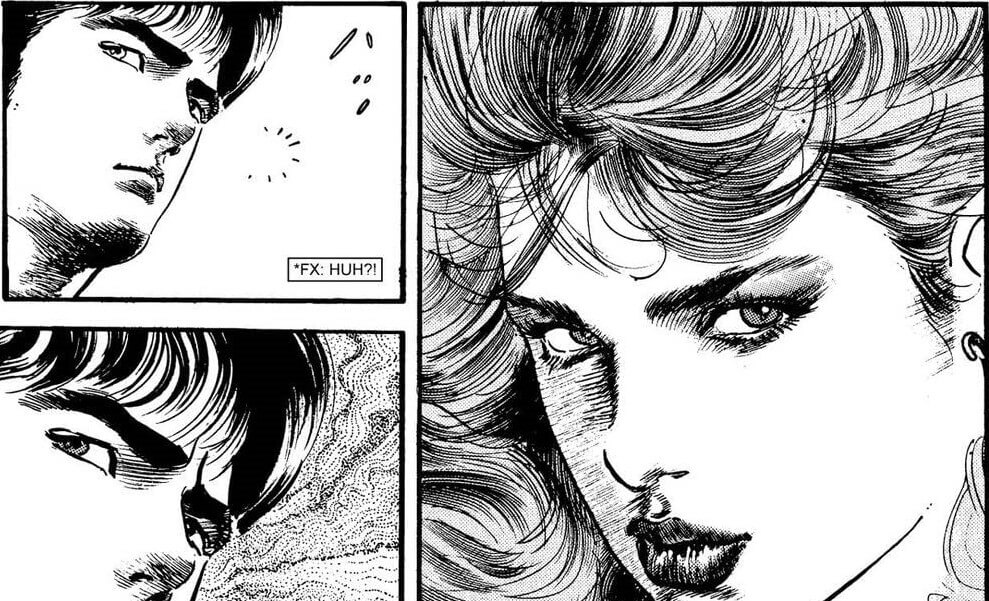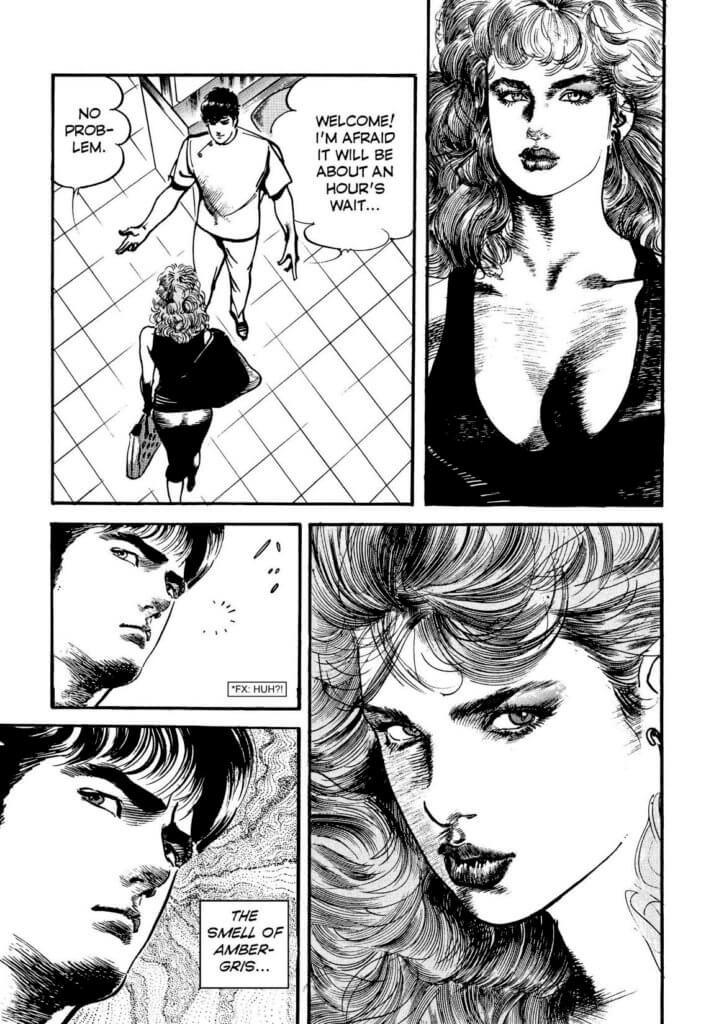As a critic, I am called to say things that will irritate and annoy people and as such I would like to begin here by graciously sharing that I hate it very much when writers say things like, “I keep my panel per page count low, because someone has to draw it!!” I appreciate all of the arguments that are made in support of this stance and I continue to find the result to be, most of the time, negatively impactful upon the final products. Someone has to draw it; I have to read it. We’re all in hell together.
However, I have come to a revision of my disdain. While reading one of my most-admired comics, a book in which pages of thirteen panels are not unheard of and eight (as seen below) or nine ones rather common, I discovered that in fact a five panel per page count average was (almost) present. I come before you to bend the knee on this matter.
Now, I have not done extensive research, but I have done some. To come to this understanding, I counted the panels per page of the last ten chapters of volume three of Crying Freeman, of the Dark Horse omnibus release. These chapters are all allotted eighteen pages, and some of them only use seventeen, featuring a non-narrative spot illustration on the final page. This decision alone is indicative of a strong rhythmic hand: if you can tell it better in one page less, do it. Make the stronger choice. But here is how I proceeded:
- Count the number of panels on each page of the chapter, marking the number down.
- Add up all of those numbers.
- Divide that number by the number of pages used in active storytelling for this chapter.
- Note that number; continue the process with the next chapter.
- When all chapters are counted and divided, add up all of the resultant numbers.
- Divide that by the number of chapters assessed.
The number I came up with was five with a decimal number below five—an inappropriate result, as you cannot have “half” (or less than half) of a panel. Panels cannot be divided without reproducing, that is, if you divide a panel you simply find yourself with “a panel, and another panel.” So, as the decimal number was under halfway towards six, I rounded down instead of up: Crying Freeman, in the excerpt assessed, has a panels per page average of five. This was surprising, as I associate it so heavily with many-panelled pages! I decided to look at how many pages per chapter actually featured five panels. I also decided to roll in six panel pages to this stage of the counting, as after all the true average was over five. This may be bad maths—somebody stop me.
Once again the number that I came up with was “about five.” On average, as a round number, five pages per chapter were five or six panel pages. This is less than a third of each chapter—whether seventeen or eighteen pages were used to relay a chapter, slightly fewer than one in three of those pages were likely to hold the average number of panels. Let’s get loose: for seventeen pages, in the simplest rhythmic occurrence, you’d read a chapter with panels per page counts like this:
Lower
Average
Higher
Lower
Average
Higher
Lower
Average
Higher
Lower
Average
Higher
Lower
Average
Higher
Lower
In fanciful terms, it’s a waltz. Rather nice as a change from a plod. Most simply, it might look like
4
5
6
4
5
6
4
5
6 (etc),
Or,
3
5
7
3
5
7
3
5
7 (etc)—the “Lower” being equally below the “Average” as the “Higher” is above.
But no chapters of Crying Freeman are presented this simply. The most reliable aspect of its rhythm control is in the splash cover that starts every chapter. They are all a single panel that contain narrative relevance as well as the title and the ceremony of “beginning.” Crying Freeman of course being a manga serial was originally published in magazine format, without its own different-stock front cover. The strip would need to announce itself within its context. This one-panel page tradition is a formal constraint turned into an elegant formality, and that alone reliably brings down the average.
Within these ten chapters, the highest number of panels in evidence on one page is thirteen, and it’s a number hit most irregularly. That’s a much higher “Higher” than seven! You couldn’t use a thirteen panel page in a regularly rhythmic sequence because thirteen is eight higher than five: you can’t go eight lower than five, because five take away eight is minus three. You cannot create a page with minus three panels on it (unless you cut windows through to a previous page, recontextualising what’s seen though…No. That’s a tangent too large and too extra-price to be relevant to this wider discussion); the lowest number of panels you can fit onto a page is one.
(A blank page is either a panel full of nothing or not a page within the comic.)
But if we’re looking at a thirteen panel page from our five panel average, and thinking “I can’t balance that out with a Lower page,” we need to do the obvious and use more than one page. Thirteen is eight more than five, and eight doesn’t fit inside of five—well half of eight is four, and you can fit four inside of five no problem. So we do that, and we do it twice.
Again, keeping it in sequence, we get:
Lower (1)
Lower(1)
Average (5)
Higher (13)
We have four pages here, and on average they should have five pages. That means that all together, between them, these four pages should have twenty panels (5 x 4 = 20). Let’s see:
1 + 1 = 2
2 + 5 = 7
13 = 7 = 20
Great! We’ve stayed within our average, but we’ve made a much more arresting rhythm, and had far more power of decision. We can reassemble those numbers into any order we like, depending on how we think they’ll play our scene. Look:
1
13
5
1
You still get twenty; a five panel per page average
13
5
1
1
You still get twenty; a five panel per page average
5
1
1
13
You still get twenty; a five panel per page average.
Now these rhythms might not serve your story; they’re not intended to be a template to which you adhere. They’re just numbers—numbers that make a point of elasticating your options as a cartoonist, or as a writer who feels obliged to offer a collaborator a set number of panels but not control over where they occur. This rhythmic command of layout and the ever-fabled pace is efficacy that, once noticed, creates enormous delight in a reader. And if it goes unnoticed? It’s still bloody lovely, because it’s the very nature of the product, the most immediate function of a comic as a read object.

(The actual sequence in the chapter featuring a thirteen panel page is like this:
1
6
5
9
1
7
8
13
3
9
6 (some “panels” are previous pages collaged on, not intended to be fully read but visible as flashback moments)
7
7
5
5
4
4
1
And that is the end of that.



